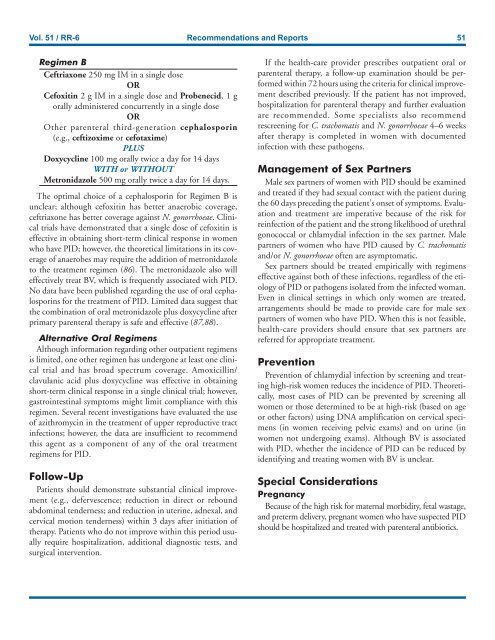You also want an ePaper? Increase the reach of your titles
YUMPU automatically turns print PDFs into web optimized ePapers that Google loves.
Vol. 51 / RR-6 Recommendations and Reports 51<br />
Regimen B<br />
Ceftriaxone 250 mg IM in a single dose<br />
OR<br />
Cefoxitin 2 g IM in a single dose and Probenecid, 1 g<br />
orally administered concurrently in a single dose<br />
OR<br />
Other parenteral third-generation cephalosporin<br />
(e.g., ceftizoxime or cefotaxime)<br />
PLUS<br />
Doxycycline 100 mg orally twice a day for 14 days<br />
WITH or WITHOUT<br />
Metronidazole 500 mg orally twice a day for 14 days.<br />
The optimal choice of a cephalosporin for Regimen B is<br />
unclear; although cefoxitin has better anaerobic coverage,<br />
ceftriaxone has better coverage against N. gonorrhoeae. Clinical<br />
trials have demonstrated that a single dose of cefoxitin is<br />
effective in obtaining short-term clinical response in women<br />
who have PID; however, the theoretical limitations in its coverage<br />
of anaerobes may require the addition of metronidazole<br />
to the treatment regimen (86). The metronidazole also will<br />
effectively treat BV, which is frequently associated with PID.<br />
No data have been published regarding the use of oral cephalosporins<br />
for the treatment of PID. Limited data suggest that<br />
the combination of oral metronidazole plus doxycycline after<br />
primary parenteral therapy is safe and effective (87,88).<br />
Alternative Oral Regimens<br />
Although information regarding other outpatient regimens<br />
is limited, one other regimen has undergone at least one clinical<br />
trial and has broad spectrum coverage. Amoxicillin/<br />
clavulanic acid plus doxycycline was effective in obtaining<br />
short-term clinical response in a single clinical trial; however,<br />
gastrointestinal symptoms might limit compliance with this<br />
regimen. Several recent investigations have evaluated the use<br />
of azithromycin in the treatment of upper reproductive tract<br />
infections; however, the data are insufficient to recommend<br />
this agent as a component of any of the oral treatment<br />
regimens for PID.<br />
Follow-Up<br />
Patients should demonstrate substantial clinical improvement<br />
(e.g., defervescence; reduction in direct or rebound<br />
abdominal tenderness; and reduction in uterine, adnexal, and<br />
cervical motion tenderness) within 3 days after initiation of<br />
therapy. Patients who do not improve within this period usually<br />
require hospitalization, additional diagnostic tests, and<br />
surgical intervention.<br />
If the health-care provider prescribes outpatient oral or<br />
parenteral therapy, a follow-up examination should be performed<br />
within 72 hours using the criteria for clinical improvement<br />
described previously. If the patient has not improved,<br />
hospitalization for parenteral therapy and further evaluation<br />
are recommended. Some specialists also recommend<br />
rescreening for C. trachomatis and N. gonorrhoeae 4–6 weeks<br />
after therapy is completed in women with documented<br />
infection with these pathogens.<br />
Management of Sex Partners<br />
Male sex partners of women with PID should be examined<br />
and treated if they had sexual contact with the patient during<br />
the 60 days preceding the patient’s onset of symptoms. Evaluation<br />
and treatment are imperative because of the risk for<br />
reinfection of the patient and the strong likelihood of urethral<br />
gonococcal or chlamydial infection in the sex partner. Male<br />
partners of women who have PID caused by C. trachomatis<br />
and/or N. gonorrhoeae often are asymptomatic.<br />
Sex partners should be treated empirically with regimens<br />
effective against both of these infections, regardless of the etiology<br />
of PID or pathogens isolated from the infected woman.<br />
Even in clinical settings in which o<strong>nl</strong>y women are treated,<br />
arrangements should be made to provide care for male sex<br />
partners of women who have PID. When this is not feasible,<br />
health-care providers should ensure that sex partners are<br />
referred for appropriate treatment.<br />
Prevention<br />
Prevention of chlamydial infection by screening and treating<br />
high-risk women reduces the incidence of PID. Theoretically,<br />
most cases of PID can be prevented by screening all<br />
women or those determined to be at high-risk (based on age<br />
or other factors) using DNA amplification on cervical specimens<br />
(in women receiving pelvic exams) and on urine (in<br />
women not undergoing exams). Although BV is associated<br />
with PID, whether the incidence of PID can be reduced by<br />
identifying and treating women with BV is unclear.<br />
Special Considerations<br />
Pregnancy<br />
Because of the high risk for maternal morbidity, fetal wastage,<br />
and preterm delivery, pregnant women who have suspected PID<br />
should be hospitalized and treated with parenteral antibiotics.


